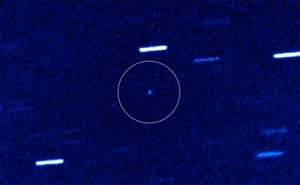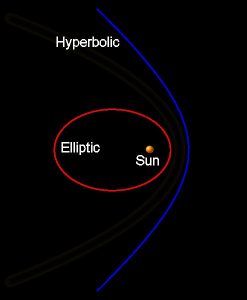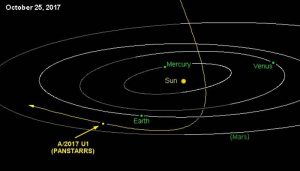It was only last October that astronomers discovered the first known interstellar visitor to our Solar System. (See my post of 4Nov17) The asteroid, which was discovered by the Panoramic Survey Telescope and Rapid Response System or Pan-STARRS telescope in Hawaii, was moving much too fast for the Sun’s gravity to keep it in a permanent orbit so it must have come from interstellar space and only spent a short period of time going around our Sun.
Astronomers named the asteroid Oumuamua, Hawaiian for scout, and we learned quite a lot about it in the few months Oumuamua was close enough to study. Astronomers found the composition of Oumuamua was like that of an iron-nickel meteorite than a dirty snowball like a comet. They also discovered that Oumuamua possessed a very unusual cigar shape being at least ten times longer than it was wide. The image below is an artist’s impression of Oumuamua.
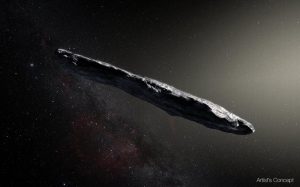
Now the astronomers at Pan-STARRS have discovered another asteroid that, while it is a permanent member of our Solar System, its orbit is so strange that it may not be an original member. Orbital simulations suggest that it could be an interstellar immigrant.
The new find hasn’t been given a name yet so I’ll be using its astronomical designation, which is 2015 BZ509. Now 2015 BZ509 orbits the Sun with a semi-major axis (Average distance) only slightly less than that of Jupiter. The most unusual thing about its orbit however is that 2015 BZ509 orbits in the opposite direction of nearly every other object in the Solar System. It has what is called retrograde motion. The image below shows a telescopic view of 2015 BZ509, it’s in the yellow circle.
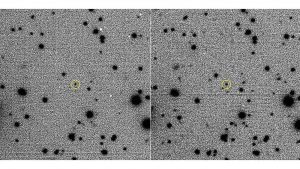
To understand what retrograde means let’s imagine ourselves looking down on the Solar System from the Sun’s north pole (which happens to correspond to Earth’s north pole). Looking at the image below of the inner Solar System ( the whole thing is too big to really illustrate my point), the orbits of the planets, the spin of the Sun and the spins of all of the planets, even the motions of the major moons all go counterclockwise. The reason for this is simple; the original gas and dust cloud that formed our Solar System must have had a counterclockwise spin and so the Sun, the planets and all of the moons shared that counterclockwise motion.
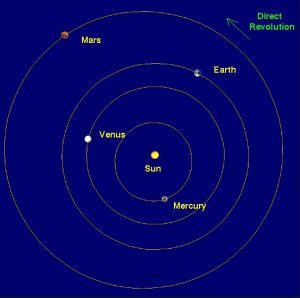
Objects that orbit in a clockwise motion are very rare, but not completely unknown. There is an entire class of objects known as Centaurs who orbit the Sun between the orbits of the gas giant planets (Jupiter, Saturn, Uranus and Neptune). This small number of asteroids are of great interest to astronomers simply because of their unusual orbits and astronomers have done an enormous amount of computer modeling trying to understand how those asteroids got those orbits. What they found was that the powerful gravity of the gas giants could capture an object out of the Ort cloud and an object so captured could on occasion wind up going the wrong way. Astronomers also found that such orbits are unstable, lasting less than 100 million years. The image below shows a few of the crazy orbits of the Centaur asteroids.
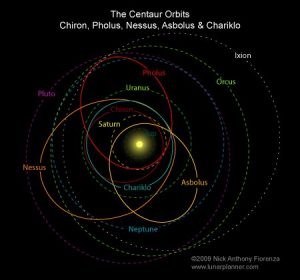
2015 BZ509 isn’t a Centaur however, it’s not between two gas giants its in an orbit very similar to Jupiter’s only backward. And when researchers F. Namouni of the Universite Cote d’Azur in Nice France and M. H. M. Morais of the Universidade Estadual Paulista in Sao Paulo Brazil carried out one million simulations of the orbit of 2015 BZ509 they found that its orbit was stable going back to the very beginning of our Solar System four and a half billion years ago.
So if 2015 BZ509 has been sitting around Jupiter pretty much since the formation of Jupiter and the other planets how did it get its backwards orbit. Doctors Namouni and Morais theorize that, back when the Solar System was very young and we were a part of a star cluster like the Pleiades or the Orion nebula 2015 BZ509 could have been grabbed from another star system that was also in the process of formation.
Personally I think that claiming that 2015 BZ509 is interstellar in origin just because it has a very unusual, but nevertheless stable orbit is a bit of a stretch. I want to see some more evidence, and I expect I’ll get my wish as astronomers continue to study this fascinating object.
P.S. Orbital dynamics isn’t my forte but I do know how to calculate the difference between the specific energy of an object (that’s the energy per kilogram of mass) between being free of the Sun’s gravity and being captured at Jupiter’s orbit. I calculate that 2015 BZ509 would have to have somehow lost 85 million Joules of energy for every kilogram of its mass if it is an interstellar immigrant. That’s lot so you can see why I’m more than a little doubtful!

